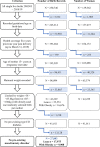A potential role for insulin treatment during pregnancy in reducing postpartum psychological distress in maternal obesity: an administrative population health study
- PMID: 33743677
- PMCID: PMC7981977
- DOI: 10.1186/s12905-021-01261-0
A potential role for insulin treatment during pregnancy in reducing postpartum psychological distress in maternal obesity: an administrative population health study
Abstract
Background: Studies have found an association between obesity and an increased risk for peripartum depression, which has also been linked to decreased placental lactogen levels. In addition, women with obesity treated for gestational diabetes with insulin were found to have increased levels of placental lactogen. Treatment options exist for perinatal and postpartum depression however they pose a risk to the developing offspring. Thus, prevention as well as markers for early identification of peripartum depression are needed. Therefore, our study objective is to identify the association between insulin treatment in pregnancy and the risk of postpartum psychological distress (abbreviated here as PPD) among cohorts of women with and without obesity.
Methods: Administrative health data (2002/03-2018/19) were used to identify a cohort of women (age 15+ years) who gave birth (N = 250,746) and had no pre-existing mood/anxiety disorders or diabetes (N = 222,863 excluded). Women were then divided into two groups: lean (N = 17,975) and with obesity (N = 9908), which was identified by a recorded maternal weight of > 38 to < 65.6 kg and ≥ 85 to < 186 kg (respectively). The risk of PPD within one year after delivery with and without insulin treatment was assessed by Poisson regression analysis. Models were adjusted for maternal age group (at pregnancy start date) and area-level income (at delivery).
Results: The unadjusted risk of PPD was higher in the obesity group (8.56%; 95% CI 8.00-9.15) than in the lean group (6.93%; 95% CI 6.56-7.33). When no insulin treatment was given during pregnancy, mothers with obesity had a significantly higher risk of PPD than the lean group (aRR 1.27; 95% CI 1.17-1.39; p < 0.0001). However, when women with obesity and insulin treatment were compared to the lean group with no insulin treatment, no significant difference in the risk of PPD was observed between the groups (aRR 1.30; 95% CI 0.83-2.02; p = 0.248).
Conclusion: This is the first study to demonstrate a positive association between insulin treatment in pregnancy among women with obesity and reduced PPD rates, suggesting insulin as a possible preventative measure. However, the biological mechanism behind the observed positive effect of insulin on PPD rates remains to be investigated.
Keywords: Administrative data; Epidemiology; Gestational diabetes; Human placental lactogen; Insulin; Maternal obesity; Mood and anxiety disorder; Postpartum psychological distress; Pregnancy.
Conflict of interest statement
The authors report no conflict of interest and no financial disclosures. The results and conclusions are those of the authors and no official endorsement by MCHP, the Manitoba Health, Seniors & Active Living (MHSAL), or other data providers is intended or should be inferred.
Figures


Similar articles
-
Intimate partner violence victimization during pregnancy increases risk of postpartum depression among urban adolescent mothers in South Africa.Reprod Health. 2023 May 2;20(1):68. doi: 10.1186/s12978-023-01605-z. Reprod Health. 2023. PMID: 37131269 Free PMC article.
-
Evaluation of antenatal risk factors for postpartum depression: a secondary cohort analysis of the cluster-randomised GeliS trial.BMC Med. 2020 Jul 24;18(1):227. doi: 10.1186/s12916-020-01679-7. BMC Med. 2020. PMID: 32703266 Free PMC article. Clinical Trial.
-
The risk factors for postpartum depression: A population-based study.Depress Anxiety. 2017 Feb;34(2):178-187. doi: 10.1002/da.22597. Epub 2017 Jan 18. Depress Anxiety. 2017. PMID: 28098957 Free PMC article.
-
[GABAergic approach of postpartum depression: A translational review of literature].Encephale. 2020 Apr;46(2):123-134. doi: 10.1016/j.encep.2019.09.007. Epub 2019 Nov 22. Encephale. 2020. PMID: 31767256 French.
-
Diagnosis of peripartum depression disorder: A state-of-the-art approach from the COST Action Riseup-PPD.Compr Psychiatry. 2024 Apr;130:152456. doi: 10.1016/j.comppsych.2024.152456. Epub 2024 Jan 29. Compr Psychiatry. 2024. PMID: 38306851 Review.
Cited by
-
The Prolactin Family of Hormones as Regulators of Maternal Mood and Behavior.Front Glob Womens Health. 2021 Dec 1;2:767467. doi: 10.3389/fgwh.2021.767467. eCollection 2021. Front Glob Womens Health. 2021. PMID: 34927138 Free PMC article. Review.
References
-
- Statistics Canada. Table 13-10-0096-01 Health characteristics, annual estimates. 2019. https://www150.statcan.gc.ca/t1/tbl1/en/tv.action?pid=1310009601. Accessed 27 Nov 2019.
Publication types
MeSH terms
Substances
Grants and funding
LinkOut - more resources
Full Text Sources
Other Literature Sources
Medical

